Ukulele is a small but versatile and powerful instrument that has become quite popular in recent years.
This versatile instrument can be used to play a wide range of genres from pop to rock, and even classical and country music.
There are several advantages of the ukulele over the guitar and other stringed instruments. But the most advantageous thing is playing chords on this tiny instrument is very easy.
Even if you know just 4 basic ukulele chords, you can play many popular songs and start your journey toward mastering this amazing instrument.
In this quick guide, I will show you what are these chords and how to play and practice them on the ukulele.
But first, you should know,
Contents
- Why Learning Chords is Essential for Ukulele Players?
- Ukulele Chord Notation
- Finger Placement on Ukulele
- The C Chord on Ukulele: How to Play and Practice
- The G Chord on Ukulele: How to Play and Practice
- The F Chord on Ukulele: How to Play and Practice
- The Am Chord on Ukulele: How to Play and Practice
- Common Chord Progressions on Ukulele
- Tips for Quickly Mastering Chords on Ukulele
- Conclusion
Why Learning Chords is Essential for Ukulele Players?
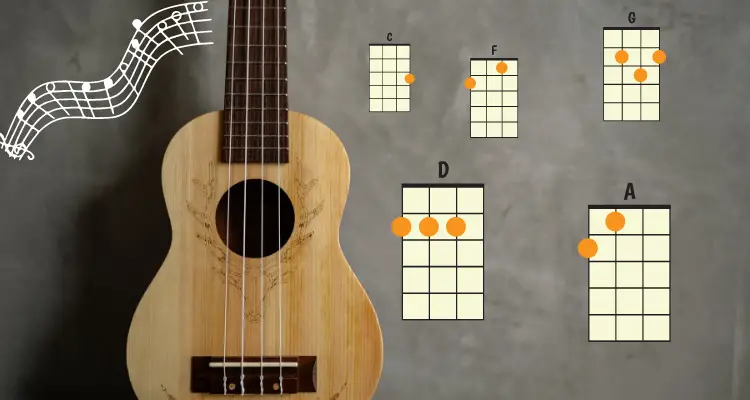
Assuming you are a beginner, let me explain what are chords and why you need to learn to play them.
Disclosure: This post may contain affiliate links, which means we may receive a commission if you click a link and purchase something that we recommended. Read more about Affiliate disclosure here.
Chords are the building blocks of music. They are groups of notes that are played together to create a harmonious sound.
Here are the reasons why chords are essential for Ukulele players.
- Chords allow you to accompany a vocalist in a variety of songs and styles of music and provide the foundation.
- If you know chords then you can strum along with the rhythm and complement the melody.
- Chords are essential to develop muscle memory, which is a crucial skill for playing any musical instrument.
- Chords allow you to create your own music and experiment with different chord progressions.
- Chords are an essential ingredient of songwriting.
If you want to play the ukulele or any other staple musical instrument then chords are the first thing to learn.
Ukulele Chord Notation
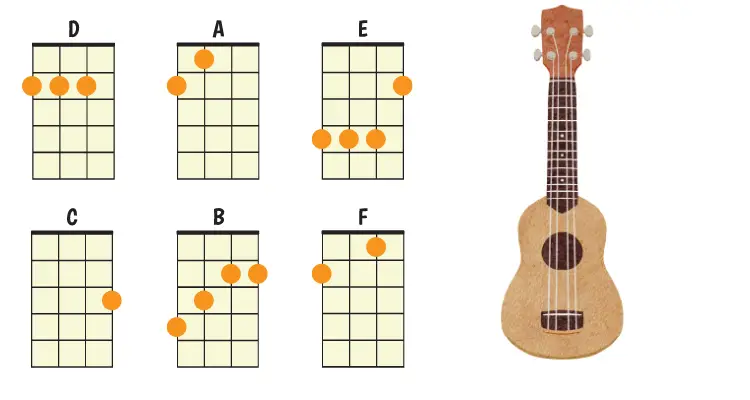
Chord notation consists of a letter and a symbol, that represents the root note and the type of chord.
For example, the notation for a C major chord is “C”. Whereas the notation for a G major chord is “G”, and so on.
There are two types of chords: MAJOR and MINOR chords. Major chords are written as “C”, “G” etc Where minor chords are represented as “Cm”, “Gm”.
Chord notation may also include additional symbols such as numbers or lines. These symbols indicate the fret where you have to place your finger or which string to play.
For example, the notation for a C major chord played in the first position is represented as “C”, but the notation for a C major chord played in the 5th position is represented as “C5”.
Finger Placement on Ukulele
Let’s start with C major chord on the ukulele.
To play the C major chord at the 1st position on the ukulele you have to place your ring finger on the 3rd fret of the 4th string and keep the other strings open.
When you strum all 4 strings of the ukulele together, you will hear a full C major chord.
Different chords have different finger positions and you have to learn them separately.
On paper, these are called “Ukulele Chord Tabs” in which the finger placements are shown as per the fingers’ numbering on the strings.
Generally, a ukulele chord tab is a drawing where all 4 strings are drawn over a part of the fretboard, and fingers are indicated in these numbers.
- Index finger – number 1
- Middle finger – number 2
- ring finger – number 3
- Pinky – number 4

It’s very easy to read ukulele chord tabs. With the help of chord tab patterns, you can easily get to know the exact finger placement for a particular chord.
Here are some examples of Ukulele chords tabs.
Now let’s learn to play the 4 basic Ukulele chords that can be used in hundreds of songs.
First off,
The C Chord on Ukulele: How to Play and Practice
The C chord or C major chord is the simplest chord to play on the ukulele.
You just need to place your ring finger on the 3rd fret of A string (4th string) and keep other strings open.
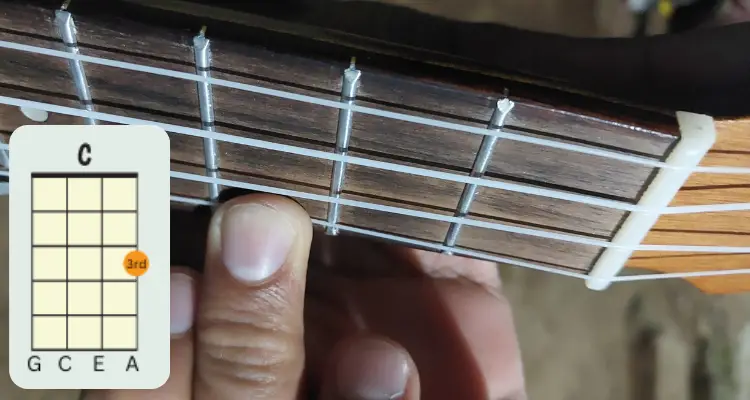
When you strum all 4 strings on the ukulele, you will hear a full-scale C chord.
You must ensure that your finger is placed just behind the fret, as close to the fret as possible but don’t touch the fret. You should strum with the tips of your fingers and not your nails.
Once you feel comfortable playing the C chord then you should practice transitioning to other chords like C-F-G or C-Am-F.
When you practice chord switching regularly you will be getting more and more accurate on it. This will help you develop your muscle memory and improve your skills over Ukulele.
Now let’s move to the 2nd basic Ukulele chord.
The G Chord on Ukulele: How to Play and Practice
The G chord is another essential chord of ukulele. It is used in the C chord progression so you must learn it after the C chord.
To play and practice the G chord on the ukulele here is the position of the fingers.
- Ring finger on the 3rd fret of the E string.
- Middle finger on the 2nd fret of the A string.
- Index finger on the 2nd fret of the C string.
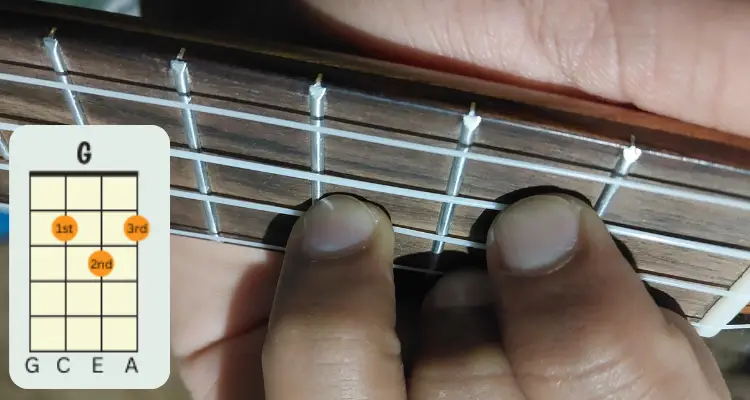
Each finger should be placed just behind the fret, as close to the fret as possible without touching it. Otherwise, the sound will not come clear.
Strum all 4 strings of the ukulele. If you hear any notes sound muted or buzzy, adjust your finger placement accordingly.
You can exchange the fingers at your ease. Now practice transitioning to other chords like G-C-D or G-Em-C.
At this stage, you should start practicing with a metronome. This will help you develop a sense of timing and rhythm.
The F Chord on Ukulele: How to Play and Practice
F chord is another simple but important chord to learn on the ukulele. It’s used in many songs and chord progressions, especially C root scale chord progression.
To play F chord on Ukulele follow this process.
- Place your index finger on the 1st fret of the E string.
- Place your middle finger on the 2nd fret of the G string.
- Keep other strings open.
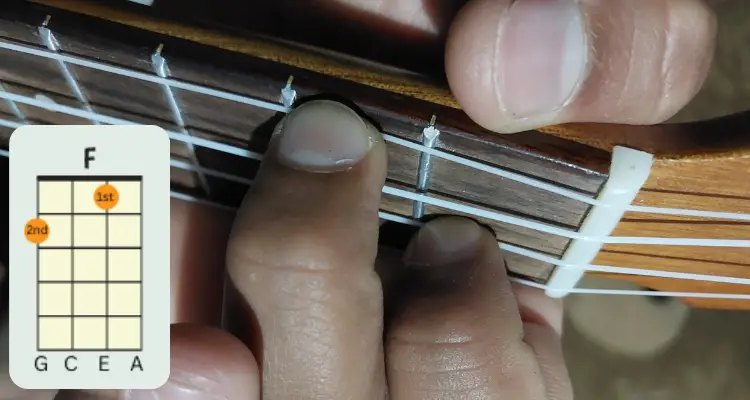
Each finger should be placed just behind the frets. but don’t touch the frets.
Now when you strum all 4 strings of the ukulele together, you will hear the full-scale F chord. You can adjust your finger placements according to your needs.
Make sure your fingers should not touch the open strings otherwise, you would hear muted or buzzy strings sound.
The Am Chord on Ukulele: How to Play and Practice
A minor is another simple but widely used chord. It’s the 6th scale from C major so generally used in C major chord progressions.
Playing A minor chord on the ukulele is really simple.
Finger position for A minor chord on Ukulele
- Middle finger on the 2nd fret of the G string.
- Other strings open position.
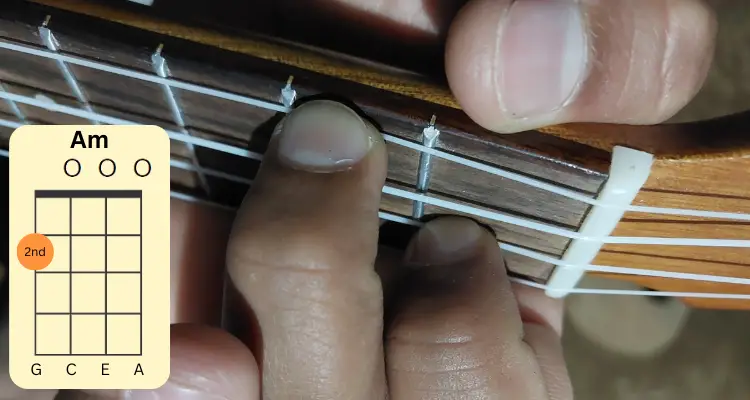
That’s it.
The strumming process is the same as other chords. You can start with simple chord progressions like Am-F-C or Am-G-Em, and practice switching between chords smoothly and quickly.
Soon, you will develop muscle memory and improve your overall playing ability for this chord.
If you know these 4 chords you can play thousands of songs based on these chords and progressions.
Common Chord Progressions on Ukulele
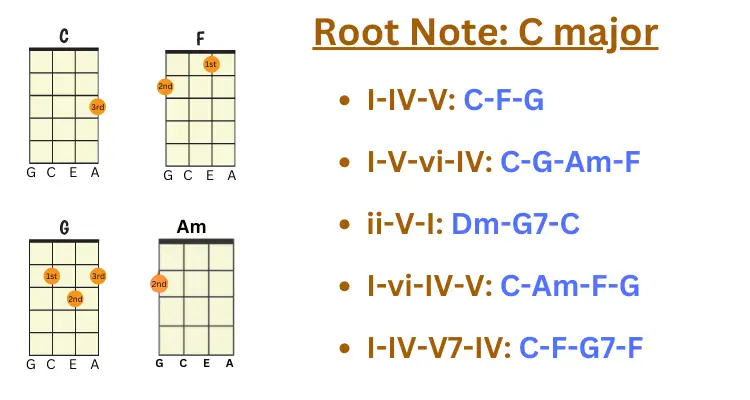
Above you’ve learned 4 basic chords on the ukulele. Now it’s time to put them together and practice common chord progressions.
Chord progressions are a series of chords played in a specific order and timing, according to the song’s root scales. Chord progression is the backbone of any song.
Common chord progressions that you can practice on the ukulele:
- I-IV-V Progression: This is one of the most common chord progressions in most music genres. For the root note C, the I-IV-V progression would be C-F-G. As you’ve just learned these 3 chords you can easily practice strumming each chord evenly and transition smoothly between them.
- I-V-vi-IV Progression: This chord progression is also based on C-G-Am-F, if the root note is C.
- ii-V-I Progression: If you love jazz then this chord pattern is for you. It is common in jazz and can add a sophisticated touch to your playing. For the C root note, the ii-V-I progression is associated with Dm-G7-C. G7 is a new chord in this progression. You need to learn G7 to play this chord progression.
- I-vi-IV-V Progression: This is another common chord progression that is used in several popular songs. For the root note C, the I-vi-IV-V progression will be associated with C-Am-F-G.
- I-IV-V7-IV Progression: This is similar to the I-IV-V progression, but here a new chord is added which is the seventh chord to the V chord. For the root note C, the I-IV-V7-IV progression would be C-F-G7-F.
You can see most of the chord progressions are based on our 4 common chords; C, F, G, and Am. So, if you know how to play these 4 chords you can easily accompany any song based on these chords.
You can even write your own songs.
Tips for Quickly Mastering Chords on Ukulele
Mastering chords on the ukulele takes time, patience, and practice, but if you follow some tips given below then you can improve more quickly:
- Practice regularly: When it comes to learning any skill you need to be consistent. Set a routine for regular practice time, and stick to it. Even if you are practicing for just 10-15 minutes a day it can make a big difference in your progress.
- Break it down: Breaking down the chords and progressions into smaller parts helps you to understand the basics and develop muscle memory fast. Such as you should place one finger at a time, and then gradually add the rest of the fingers. This can help you to easily memorize the finger positions.
- Start using a metronome: Once you become familiar with the basic chords, start strumming or picking each chord with a metronome. You can find a metronome app on your mobile and buy a physical metronome online. A metronome can help you develop your sense of timing and rhythm which will help you further accompany other musicians and vocalists.
- Practice chords transition: Practice transitioning between chords according to the chord progressions I have given above. You can break down the pro This can help you develop muscle memory and make it easier to switch between chords in a song.
- Experiment by adjusting finger positions: Adjust the finger positions to see which position produces the clearest sound. Even small adjustments can make a big difference in the quality of your ukulele’s sound.
- Practice with your favorite songs: Practice playing chords along with your favorite songs. This will help you develop a better understanding of how chords are used in songs.
- Take breaks: Take regular short breaks otherwise, you’ll feel overwhelmed.
Conclusion
Learning chords on the ukulele or any other instrument is an essential part of your learning.
When you understand chord notation, finger placement, and positions, and practice common chord progressions, you will start developing your ability to play a variety of songs and even write your own music.
Take your time and practice regularly. With patience, dedication, and the tips I have given above, you’ll soon master chords on the ukulele and enjoy your ukulele journey.
Related,
